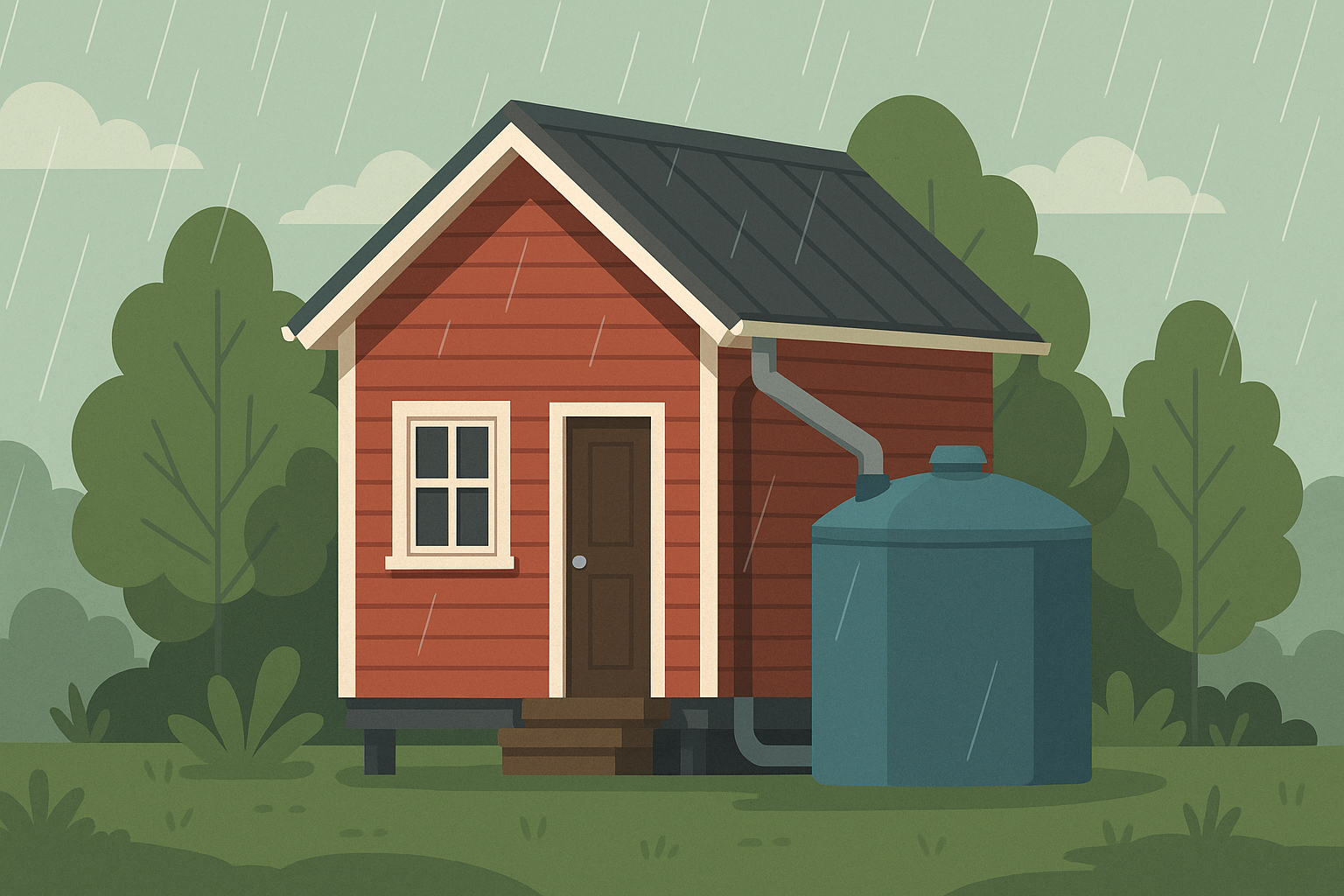
Estimated reading time: 8 minutes
Key Takeaways
- Water Independence: Rainwater harvesting offers a reliable, off-grid water source for tiny homes in Canada.
- Integrated Approach: An effective system combines collection, filtration, and storage for sustainable water management.
- Climate Resilience: Designs must adapt to variable rainfall, freezing temperatures, and snow accumulation specific to Canadian climates.
- Regulatory Compliance: Meeting local codes and guidelines is crucial for safe, legal installations.
Table of Contents
- What Is Rainwater Harvesting?
- Why Water Filtration Is Essential in Rainwater Harvesting
- Space-Saving Water Storage for Tiny Homes in Canada
- Climate and Regulatory Considerations for Tiny Homes Canada
- Integrating Water Management in Eco-Friendly Tiny Homes
- Conclusion: Sustainable Water Management for Tiny Homes in Canada
- Frequently Asked Questions
What Is Rainwater Harvesting?
Rainwater harvesting is the process of collecting rain or melting snow from roof surfaces using gutters and downpipes, then storing this water in tanks or cisterns for future use. This practice is particularly suited for eco-friendly homes and is becoming popular among tiny homes in Canada, where residents seek sustainable and independent water solutions.
How Rainwater Harvesting Systems Work
- Collection: Rainwater falls onto the roof and is directed into gutters.
- Redirection: Downpipes channel the water into storage tanks or underground cisterns.
- Filtration & Treatment: The collected water can be filtered for non-potable uses such as irrigation, or treated for potable uses with advanced filtration methods.
Benefits for Tiny Homes in Canada
- Water Independence: Reduces reliance on municipal water sources, which is ideal for off-grid living.
- Eco-Friendly Impact: Helps minimize stormwater runoff and conserves treated municipal water.
- Sustainable Living: Supports environmentally responsible lifestyles, a core value of many tiny home communities in Canada.
Canadian research indicates that with proper planning and integration of storage and treatment systems, rainwater harvesting can effectively meet domestic water needs even in challenging climates. For further reading, visit Harvesting Rainwater Canada and Sustainable Technologies Wiki.
Why Water Filtration Is Essential in Rainwater Harvesting
Water filtration is a crucial step in ensuring that the collected rainwater is safe for its intended use, particularly in the constrained systems typical of tiny homes in Canada.
What Is Water Filtration?
Water filtration involves removing contaminants and particulate matter—from airborne dust and organic debris to microbes—from the collected water. This process generally employs:
- Pre-Filters: Mesh screens or leaf guards capture large debris before water enters the storage tank.
- Sediment Filters: Trap finer particles such as sand and grit.
- Carbon Filters: Eliminate odors, chlorine, and organic chemicals that may leach from roofing materials.
- UV Sterilization: Disinfects water by neutralizing bacteria, viruses, and cysts.
Effective water filtration is especially vital for tiny homes, where the system’s capacity for contamination is limited. For more detailed insights, read about Off-Grid Living in Canadian Tiny Homes.
Space-Saving Water Storage for Tiny Homes in Canada
With limited space available, water storage solutions for tiny homes must be both efficient and robust to handle harsh Canadian conditions.
- Slimline Above-Ground Tanks: These tall, narrow tanks are ideal for confined outdoor spaces.
- Underground Cisterns: Burying tanks below the frost line provides natural insulation from freezing. For example, a 1,250-gallon in-ground tank showcased on WaterFarmers demonstrates this approach.
- Custom Modular Tanks: Designed to fit uniquely shaped spaces around tiny homes, maximizing otherwise wasted areas.
When selecting a water storage system, considerations include food-grade construction materials, weather resistance, and seamless integration with collection and filtration systems. For further inspiration, check out Mini Homes: The Ultimate Guide to Compact Living.
Climate and Regulatory Considerations for Tiny Homes Canada
Tiny homes in Canada operate under unique environmental and regulatory conditions that impact rainwater harvesting systems.
- Climate Challenges:
- Snow Accumulation: Heavy snow can block gutters, requiring design modifications such as heated cables or increased roof slope.
- Freezing Temperatures: Insulated or underground components are essential to prevent water, tanks, and pipes from freezing.
- Variable Rainfall: Systems may need to be oversized to capture seasonal fluctuations in rainfall.
- Regulatory Compliance:
- Local legislation and building permits may be required, particularly for potable water installations.
- Adhering to health and safety codes is critical; consult local experts for guidelines.
An integrated approach that takes into account both environmental challenges and local regulations is key for the successful implementation of rainwater harvesting systems in Canadian tiny homes. Learn more about these legal considerations in the guide on Tiny Home Legal Requirements Canada.
Integrating Water Management in Eco-Friendly Tiny Homes
Combining rainwater harvesting, advanced water filtration, and optimized water storage creates a sustainable, efficient water management system that fits the lifestyle of tiny home enthusiasts.
Components of an Integrated System
- Rainwater Collection: Utilize roofs with NSF-approved coatings to ensure clean water capture.
- Filtration & Treatment: Protect water quality with multi-stage filters and UV disinfection units housed in insulated areas.
- Smart Storage: Pair underground or insulated tanks with automated controls that prevent freezing and maintain water quality.
Additional eco-friendly systems such as solar power for running pumps, composting toilets, and greywater recycling further enhance sustainability. For deeper insights, see Off-Grid Living in Canadian Tiny Homes.
A case study from Prince Edward County showcases a tiny home solution featuring an NSF-certified roof, below-frost-line storage, and insulated plumbing—all designed to achieve year-round water independence.
Conclusion: Sustainable Water Management for Tiny Homes in Canada
Adopting rainwater harvesting in tiny homes not only promotes sustainability but also grants residents greater water independence. This approach minimizes utility reliance while supporting eco-friendly living in the face of Canada’s varied climate.
Key Benefits
- Self-Reliance: Ensures control over the water supply for off-grid and remote living.
- Environmental Sustainability: Conserves water and reduces stormwater runoff.
- Climate Adaptation: Properly designed systems overcome seasonal extremes and regulatory challenges.
Steps for Homeowners
- Assess: Evaluate your roof’s catchment potential and local rainfall patterns.
- Research: Consult local suppliers and review applicable building codes and guidelines.
- Install: Hire experienced professionals to design and set up a system tailored to your needs.
For further resources, visit WaterFarmers, Harvesting Rainwater Canada, and Sustainable Technologies Wiki.

Frequently Asked Questions
Q: How much does a rainwater harvesting system typically cost for a tiny home?
A: Costs vary depending on system complexity, design, and installation specifics – usually ranging from a few thousand to over ten thousand dollars.
Q: Is rainwater harvesting reliable during the Canadian winter?
A: Yes, as long as the system is designed with insulated or underground storage, and proper filtration to prevent freezing and contamination.
Q: Do regulatory requirements differ across provinces?
A: Absolutely. Local building codes and regulations can vary significantly, so it’s important to consult regional guidelines and experts.
Q: Can rainwater be used for drinking in tiny homes?
A: With a well-designed multi-stage filtration and treatment process, rainwater can be made potable. Always follow local health and safety standards for potable water systems.

Leave a Reply